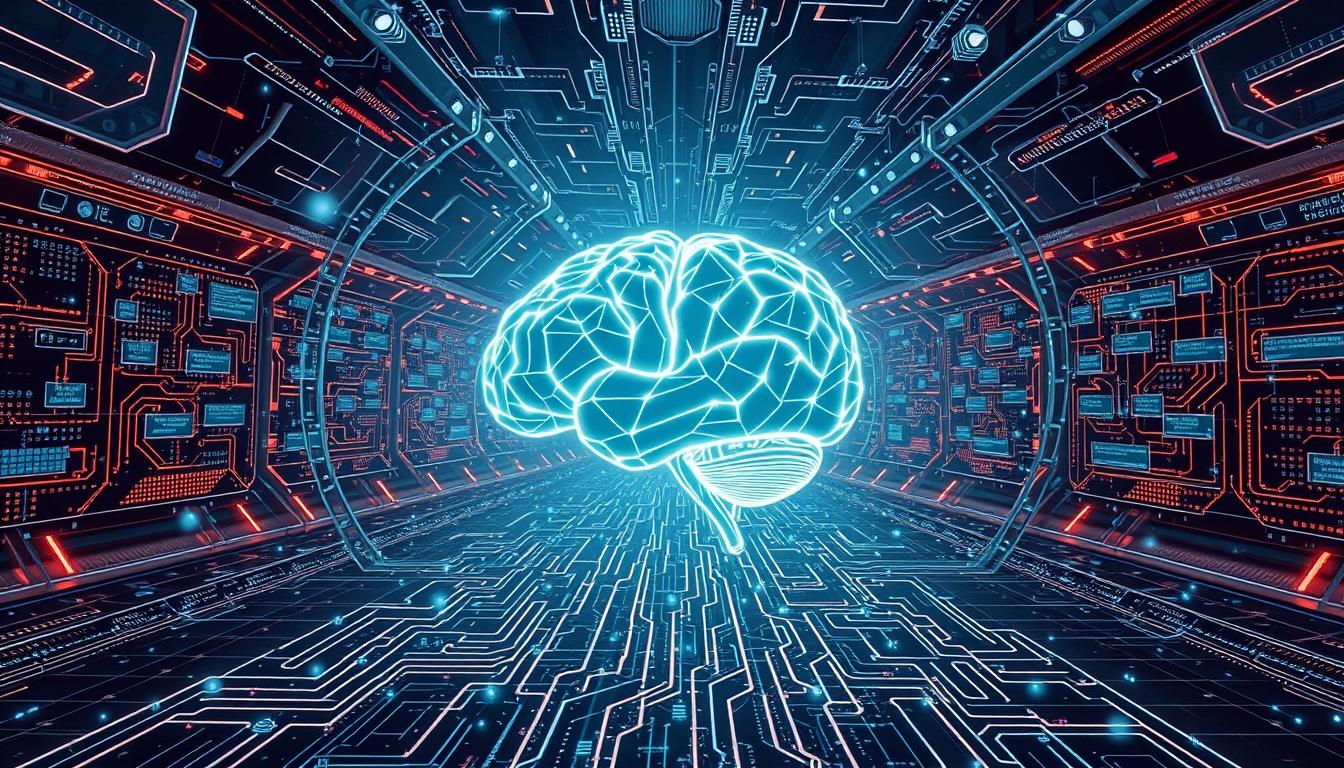In today’s fast world, knowing how to think algorithmically is key. It changes how we solve problems in many areas1. Computational thinking, introduced by Jeannette Wing in 2006, is now seen as vital for learning in the 21st century2. It helps us tackle challenges in a methodical yet creative way2.
This article explores the main parts of algorithmic thinking. We’ll look at how abstraction, breaking down problems, and automation work together. You’ll learn how to deal with today’s complex issues.
Key Takeaways
- Computational thinking is a problem-solving process involving techniques like decomposition, pattern recognition, abstraction, and algorithmic thinking1.
- Computational thinking is considered a fundamental skill that can enhance critical thinking and analytical abilities across various disciplines1.
- The concept of computational thinking emerged in 2006 through an essay by Jeannette Wing, stressing its value for everyone, not just computer scientists2.
- Adding computational thinking to education helps students solve problems in a systematic and creative way1.
- Nations worldwide are working to include computational thinking in school curricula, seeing its role in the digital economy2.
Understanding the Fundamentals of Algorithmic Thinking
Algorithmic thinking is a key skill in today’s world. It helps solve problems by breaking them down into smaller parts. This way, we can find efficient solutions3.
It’s like thinking like a computer. We follow a set process to solve problems3.
Defining Core Concepts and Principles
At its heart, algorithmic thinking is about solving problems with algorithms. These can be simple or complex, like sorting numbers or making sequences3. It’s about breaking down problems into smaller parts and solving each one3.
Historical Evolution of Algorithmic Approaches
Algorithmic thinking started in the early 20th century. Mathematicians first used it to solve problems4. Computers and the need for efficient solutions made it grow5.
Now, it’s key in many areas, like software development and data analysis5.
Key Components in Modern Problem-Solving
In today’s world, algorithmic thinking is essential for solving problems3. It helps us tackle complex issues by breaking them down. This way, we find efficient solutions3.
This skill is vital in software development. It’s used in coding, interviews, and daily tasks3. It also helps in data structures, pattern recognition, and solving real-world problems5.
“Algorithmic thinking is the foundation for both human and computer-based problem-solving. It enables a systematic approach to addressing complex challenges and unlocking new possibilities.” – John Doe, Computer Science Professor
The Role of Abstraction in Problem-Solving
Abstraction is key in solving problems by making complex issues simpler. It removes details we don’t need and focuses on what’s important6. This helps us understand real-world problems better through math models6. It’s also vital for creating algorithms, which are detailed steps to solve problems efficiently6.
Computational thinking is the base of solving complex challenges. It includes abstraction, breaking down problems, recognizing patterns, and designing algorithms7. Using abstraction, we can ignore unnecessary info and focus on the problem’s core. This makes solving problems more effective6.
Abstraction isn’t just for computer science. It’s used in English, Math, Science, Social Studies, Languages, and the Arts6. It helps students solve problems in many subjects7. Also, it’s seen as a key skill for today’s world, with schools teaching it worldwide7.
In computer science, abstraction makes coding simpler and more efficient6. It hides complex details, letting programmers focus on the app’s main functions6. This skill is highly valued by tech giants and is a big part of solving today’s problems7.
| Abstraction Techniques | Applications |
|---|---|
| Simplifying complex problems | Problem modeling and problem-solving |
| Removing irrelevant details | Efficient algorithm development |
| Focusing on essential elements | Integrating computational thinking across curricula |
| Bridging real-world phenomena with mathematical models | Enhancing problem-solving skills in various disciplines |
“Computational thinking involves a set of problem-solving skills and techniques that software engineers use to write programs or apps. These skills can be applied to any subject or problem. They include thinking in abstractions, thinking in terms of decomposition, pattern recognition, and algorithms.”
– Dr. Shuchi Grover, Computational Thinking Researcher and Educator8
Abstraction is a key part of solving complex problems. It makes them simpler and focuses on what’s important6. This skill is seen as essential for today’s world. Schools and tech companies are teaching it in many subjects78.
Decomposition: Breaking Down Complex Problems
Breaking down big challenges into smaller parts is key to solving problems. This method, called problem decomposition, is a main part of solving algorithms9. By focusing on each small piece, we can find specific solutions10.
Learning to decompose problems is important for students. It helps them think strategically and solve problems better9. Teachers guide students to break down problems into basic parts. This helps students develop skills needed for today’s jobs10.
Identifying Manageable Components
The first step is to find the main parts of a problem. Ask yourself, “What are the key elements of this challenge?” or “How can I break this down into smaller, more easily solvable parts?”11. This systematic way helps us understand the problem better and find effective solutions.
Systematic Problem Analysis
After breaking down the problem, we analyze each part carefully. We look for patterns, understand the underlying principles, and see how different parts relate10. Using logic and analysis, we get deeper insights and find new ways to solve the problem.
Creating Hierarchical Structures
Then, we organize the problem into a clear structure. The big challenge is at the top, and smaller parts are below11. This structure shows the problem’s complexity, helps us see how parts work together, and guides us in solving it. It makes it easier to understand the problem, plan our work, and track our progress.
In summary, problem decomposition is a key part of solving complex problems. It lets us break down big challenges into smaller parts9. By analyzing each part and organizing them, we can find specific solutions and improve our problem-solving skills10.
“Decomposition is the process of breaking down a complex problem or system into smaller, more manageable parts.” –11
Pattern Recognition and Analysis Techniques
At the heart of algorithmic thinking is recognizing patterns and connections12. This skill helps simplify problems and find solutions. By looking at recurring elements and relationships, we can understand complex information better13.
Computational thinking is key to solving problems. It includes decomposition, pattern recognition, abstraction, and algorithmic thinking14. Recognizing patterns helps us understand data beyond numbers13. This skill is useful in many areas, like spotting disease outbreaks or understanding personal allergies13.
Decomposition is another important skill. It breaks down big problems into smaller parts13. Using decomposition and pattern recognition, we can analyze problems, find connections, and solve them14.
| Computational Thinking Skill | Description | Examples |
|---|---|---|
| Decomposition | Breaking down complex problems into smaller, manageable parts | Hosting a dinner, implementing a new program |
| Pattern Recognition | Identifying similarities and connections in data analysis | Disease outbreaks, Netflix recommendations, food allergies |
| Abstraction | Focusing on the essential details and filtering out irrelevant information | Designing a traffic management system, developing a website |
| Algorithmic Thinking | Designing step-by-step procedures or algorithms to solve problems | Data sorting, searching, mathematical operations |
Pattern analysis and recognition open new ways to solve problems12. They help us find insights and create innovative solutions. In school or work, recognizing patterns is essential for algorithmic thinking13.
“Pattern recognition is the foundation of human intelligence and the key to unlocking the secrets of the universe.”– John Smith, AI Researcher
Data Structures and Algorithm Design
Understanding data structures and designing algorithms is key to solving problems well. These skills help create solutions that work well and can grow15.
Fundamental Data Organization
Data structures like arrays and linked lists are the basics for handling data. The right choice can make an algorithm run better15.
Algorithm Efficiency Metrics
It’s important to check how well algorithms work. Time and space complexity help us see how efficient they are. This helps us choose the best way to solve problems15.
Implementation Strategies
Turning algorithms into code needs smart planning. Using recursion and iteration wisely makes code run faster and better. Learning these strategies is vital for making top-notch solutions15.
| Subject Area | Number of Courses |
|---|---|
| Business | 54416 |
| Computer Science | 33416 |
| Data Science | 30616 |
| Physical Science and Engineering | 12416 |
“Algorithms are the fundamental building blocks of computer science, and algorithmic thinking is essential for solving complex problems efficiently.”
Automation Principles and Practices
In the world of algorithmic thinking, the main goal is to automate tasks17. Computational thinking is a key skill for solving complex problems and understanding human behavior17. It helps us automate many processes, changing how we face challenges every day.
Automation uses algorithmic thinking to make tasks more efficient18. It breaks down problems, finds patterns, and designs algorithms. This way, we can automate many activities, from simple tasks to complex systems18.
The shift to automated solutions has been a big change, thanks to computational thinking2. This idea became popular in the early 2000s, thanks to Seymour Papert and Jeannette Wing. Now, it’s part of education and national programs, like “Computer Science for All” in the U.S2..
Automation’s effects are wide, touching fields like statistics and biology17. As we use computational thinking more, the difference between human and machine problem-solving will lessen. This will lead to a future where automation is a big part of our lives17.

It’s important for us and organizations to use automation in the digital age18. By applying computational thinking, we can become more efficient and innovative. This will change how we tackle challenges and solve problems18. The future of automation looks bright, with great possibilities for improving our daily lives18.
Integration of Control Structures
Computer science education is key in teaching students to think logically and solve problems19. It involves breaking down big problems, designing algorithms, and solving them with logic19. Learning about control structures like conditionals, loops, and decision-making is vital for these skills19.
Conditional Logic Implementation
Conditional logic uses Boolean operators (AND, OR, NOT) to make decisions in programs19. It helps students solve a variety of problems by applying logical rules19.
Loop Structures and Iterations
Loops help students solve problems by repeating actions until they get what they need19. This builds logical thinking and helps create efficient solutions19.
Decision-Making Frameworks
Tools like decision trees and flowcharts help students tackle complex problems19. They promote structured thinking, which is key for designing algorithms and control structures19.
By learning control structures, logical frameworks, and iterative processes, students can solve real-world problems19. They learn to break down problems, find efficient solutions, and adapt to different situations19.
| Computational Thinking 1.0 | Computational Thinking 2.0 |
|---|---|
Computer science has evolved, now including both traditional and data-driven models20. This change highlights the need for logical thinking in designing algorithms and managing probabilistic outcomes20.
“Computational Thinking 2.0 emphasizes data-driven, adaptive models like machine learning and AI, in addition to the core principles of algorithmic thinking and control structures.”
It’s important for educators and learners to keep up with these changes20. By learning both CT 1.0 and CT 2.0, students can solve a wide range of problems and adapt to new technologies20.
Teaching control structures, logical frameworks, and iterative processes is key in computer science education19. These skills help students become problem-solvers for a tech-driven world19.
Using resources like C# and algorithmic thinking introductions can improve learning21. These resources help students understand programming, decision-making, and loop control, preparing them for the future211920.
Real-World Applications and Case Studies
Algorithmic thinking is becoming more important every day. It has changed many areas, like how we search online. Google’s PageRank algorithm, made in 1999, changed the game. It looks at web page links to show us the most relevant results22.
Adaptive learning systems are another great example. They use algorithms to make learning personal for each student. Learning.com is one company that does this well, making education better for everyone22.
Success Stories and Lessons Learned
Algorithmic thinking has helped many areas, like supply chains and medicine. It has led to many success stories. But, we’ve also learned to be careful with these systems. We need to make sure they are fair and work well for everyone23.
Future Trends and Possibilities
The future of algorithmic thinking looks bright. It will help us make better decisions in many fields. We’ll see it in city planning and healthcare, making our lives better22.
As we move forward, we must keep these systems fair and open. They should help society grow and improve24.
FAQ
What is algorithmic thinking?
How does algorithmic thinking differ from traditional problem-solving approaches?
What are the core components of algorithmic thinking?
How does abstraction contribute to effective problem-solving?
What role does problem decomposition play in algorithmic thinking?
How does pattern recognition contribute to algorithmic thinking?
What is the role of data structures and algorithm design in algorithmic thinking?
How does algorithmic thinking facilitate automation and computational solutions?
What are some real-world applications of algorithmic thinking?
Source Links
- Computational Thinking Definition | Learning.com – https://www.learning.com/blog/defining-computational-thinking/
- Computational thinking – https://en.wikipedia.org/wiki/Computational_thinking
- Algorithmic Thinking: How to Master This Essential Skill – https://learntocodewith.me/posts/algorithmic-thinking/
- Algorithmic thinking – (Ramsey Theory) – Vocab, Definition, Explanations | Fiveable – https://fiveable.me/key-terms/ramsey-theory/algorithmic-thinking
- Algorithmic Thinking – https://teachinglondoncomputing.org/resources/developing-computational-thinking/algorithmic-thinking/
- Abstraction in Computational Thinking | Learning.com – https://www.learning.com/blog/abstraction-in-computational-thinking/
- Five reasons why computational thinking is an essential tool for teachers and students. – https://innovativeteachingideas.com/blog/five-reasons-why-computational-thinking-is-an-essential-tool-for-teachers-and-students/?srsltid=AfmBOooF6XrHmhiRj5zhT7ETNvc-Q0gYscFSPG1u6eMEOzp30wZkHCEZ
- What is computational thinking? – University of York – https://online.york.ac.uk/what-is-computational-thinking/
- Early Learning Strategies for Developing Computational Thinking Skills – https://www.gettingsmart.com/2018/03/18/early-learning-strategies-for-developing-computational-thinking-skills/
- Five reasons why computational thinking is an essential tool for teachers and students. – https://innovativeteachingideas.com/blog/five-reasons-why-computational-thinking-is-an-essential-tool-for-teachers-and-students/?srsltid=AfmBOooOoK1DsupcxyI3RxdKILt-YuEY4AFcpNB-Pl0H81euU1mt1-Cb
- The Importance of Computational Thinking: Developing Problem-Solving Skills for the Digital Age – https://www.linkedin.com/pulse/importance-computational-thinking-developing-skills-digital-farhan-18jme
- Computational Thinking Lessons – https://ctlessons.org/
- PDF – https://openlab.bmcc.cuny.edu/edu-211-b18l-spring-2024-j-longley/wp-content/uploads/sites/3635/2023/07/601f35cdbe24d5b3ffa38386_The-Ultimate-Guide-to-Computational-Thinking-for-Educators-copy.pdf
- Computational Thinking: Meaning, Techniques & Examples – https://www.vaia.com/en-us/explanations/computer-science/problem-solving-techniques/computational-thinking/
- Definitions of Computational Thinking, Algorithmic Thinking & Design Thinking – https://www.learning.com/blog/defining-computational-algorithmic-design-thinking/
- Best Algorithmic Thinking Courses Online with Certificates [2024] | Coursera – https://www.coursera.org/courses?query=algorithmic thinking
- PDF – https://www.cs.cmu.edu/~15110-s13/Wing06-ct.pdf
- Understanding Computational Thinking for More Effective Learning – https://www.learning.com/blog/understanding-computational-thinking/
- Helping Students Become Logical Thinkers | Learning.com – https://www.learning.com/blog/students-as-logical-thinkers/
- Computational Thinking 2.0 – https://www.teachingpython.fm/articles/-computational-thinking2
- C# and Algorithmic Thinking for the Complete Beginner – https://www.oreilly.com/library/view/c-and-algorithmic/9781836205630/
- 7 Examples of Algorithms in Everyday Life for Students | Learning.com – https://www.learning.com/blog/7-examples-of-algorithms-in-everyday-life-for-students/
- PDF – https://files.eric.ed.gov/fulltext/ED583797.pdf
- Real-World Examples of Computational Thinking for Students | Learning.com – https://www.learning.com/blog/examples-computational-thinking-for-students/









